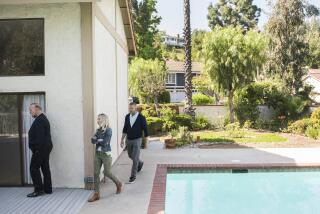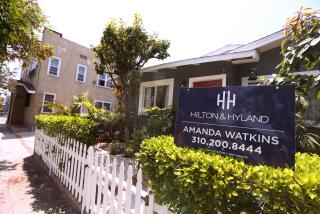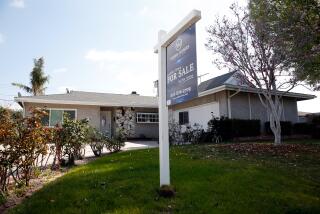L.A. County median home price ties record high as housing market sizzles
The median home price in Los Angeles County has reached the all-time high set in 2007, a milestone that follows five years of steady recovery but comes amid renewed concerns over housing affordability.
Home prices rose nearly 6% in April from a year earlier, hitting the $550,000 level where the median plateaued in summer 2007 before a sharp decline that bottomed out in 2012.
Other areas in Southern California also are hitting record levels, according to the report on regional home prices released Tuesday by CoreLogic.
Orange County surpassed its pre-bust high last year, and in April set a new record of $675,000.
San Diego County also exceeded its pre-bust peak for the first time last month, as the median price — the point at which half the homes sold for more and half for less — climbed 7.4% to $525,000.
The hot market mirrors a national upswing that economists said remains underway despite a disappointing Commerce Department report Tuesday that showed new home sales last month dropped by the most in over two years. The decline was largely described as an anomaly in the notoriously volatile measure, which has a small sample size.
Nationally, a key gauge of home prices, the Case-Shiller index, is at record levels and sales of previously owned homes — the largest share of the market — sold at the fastest pace in over a decade in March.
The rebound has been welcome news for many homeowners who are regaining equity, but it’s also locking many out of homeownership, particularly in expensive California.
“Prices are rising faster than incomes,” said Selma Hepp, chief economist with Los Angeles brokerage John Aaroe Group. “A lot of people are going to be pushed out.”
The high cost of housing is spurring a growing debate in Sacramento over how to lessen what many agree is a statewide affordability crisis. And it’s causing local buyers to increasingly look to the lower-cost Inland Empire, where developers are starting to ramp up construction on several large master-planned communities.
Still, the moves away from coastal Southern California remain far below last decade. And many economists say there are other key differences between today and last decade’s bubble, which ultimately triggered the financial crisis and lengthy recession.
Instead of reckless lending driving the upswing, economists point to an improving job market, historically low mortgage rates and a shortage of homes for sale — in other words, a more sustainable rise triggered by a mismatch between supply and demand.
“The way homes are purchased today is different than the way homes were purchased last time,” Hepp said.
The record median prices, as calculated by CoreLogic, also are nominal values that do not take into account inflation. The L.A. County median is 12.4% below the 2007 peak after adjusting for rising consumer prices.
Lower mortgage rates also have made housing more affordable than last decade, noted Chris Thornberg, founding partner of Beacon Economics, who predicted last decade’s housing crash.
And prices have consistently risen 5% to 6% each year, rather than the double-digit rates of last decade.
“It’s not a bubble,” he said of today’s market. “It doesn’t smell like a bubble. It doesn’t walk like a bubble.”
A recent report from real estate firm Trulia drilled deeper than median prices, looking at factors such as size and the values of homes not on the market. It estimated that only 37.4% of the homes in L.A. County are worth more now than at the height of the housing bubble without adjusting for inflation.
Homes that have fully recovered their value are primarily in wealthy areas along the coast or on hillsides, Trulia found, underscoring the unevenness of the economic recovery and that prices in such neighborhoods didn’t fall as much during the bust.
Across Southern California — which comprises Los Angeles, Orange, Riverside, San Bernardino, Ventura and San Diego counties — April home sales fell 4.8% from a year earlier, a drop CoreLogic blamed partly on one fewer business day last month than in April 2016. Judged by average transactions recorded daily, sales were essentially flat.
Meanwhile, the region’s median rose 6.2% from a year earlier to $485,000. That’s 4% below the nominal peak of $505,000 reached in 2007.
Riverside, San Bernardino and Ventura counties are also below their peak, but prices in those counties have been on the upswing.
Combine those trend lines with higher interest rates since the presidential election, and some real estate industry professionals say it’s clear there are some buyers acting out of fear.
“There is a general feeling that prices are too high,” said Redfin real estate agent Henry Vega. But “there is an urgency … that if we don’t buy now, we are just not going to be able to buy in the next three or five years unless there is a major crash.”
That urgency, along with a shortage of listings, has been reflected in open houses that have been packed during the spring home buying season.
Last weekend, about 100 parties came through an open house for a three-bedroom home in Gardena, Vega said. The house is now in escrow for $498,000 — nearly $50,000 over the asking price.
Edward Pinto, a fellow at the American Enterprise Institute, a conservative think tank, said it’s unlikely that home prices will decline in coming years absent a significant recession or a tragedy like a mass terrorist attack.
He said a shortage of listings and a recent easing of credit standards is pushing up prices. But, unlike some other housing experts, he thinks this cycle too will end in a crash, because national home prices have now risen beyond what is sustainable long-term.
“The longer this goes on the more painful the correction,” said Pinto, a former chief credit officer for Fannie Mae, the government-backed mortgage giant.
In L.A., the correction probably would be worse, he said, given a mismatch between home prices and income — and the county’s history of boom and bust.
“Places like L.A., every metric is flashing that these levels are unsustainable,” Pinto said.
If last time is any guide, though, it could be a while before any bust.
Fitch Ratings, which rates mortgage-backed securities, estimates that L.A. County home prices in the fourth quarter were 5.2% overvalued relative to income, rent and other factors. At the height of the bubble last decade, the company estimates prices were 35.7% overvalued.
Follow me @khouriandrew on Twitter
ALSO
Whole Foods to open lower-priced 365 store in Santa Monica
Housing construction is on the rise in California, but it’s still not enough
Writing love letters, bidding $100,000 extra: Buying a Southern California home is ‘insane’
UPDATES:
5:15 p.m.: This article was updated with additional comment and analysis.
This story was originally published at 12:05 p.m.
More to Read
Inside the business of entertainment
The Wide Shot brings you news, analysis and insights on everything from streaming wars to production — and what it all means for the future.
You may occasionally receive promotional content from the Los Angeles Times.











